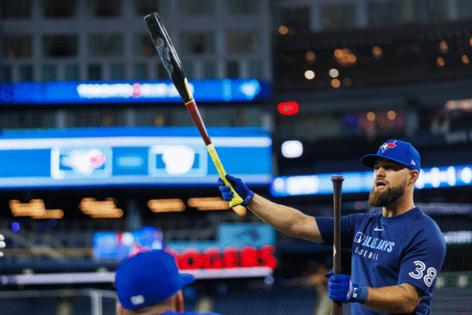Everyone is intrigued by the torpedo bat, including the Phillies. Will it be a revolution or a fad?
Published in Baseball
PHILADELPHIA — Bryson Stott doubled, homered, walked twice, scored three runs and drove in two in the Phillies' victory last Saturday in Washington. By any standard, it was a satisfying day at the plate.
Then, he heard about what the Yankees did.
Everybody heard. Nine home runs — repeat: nine home runs — for one team in a single game tend to reverberate beyond the ballpark in which they were hit. And the Yankees’ power flex went viral even faster because several of their hitters used bats with a barrel shaped like a bowling pin or, well, a torpedo.
Stott saw clips and photos on social media, and naturally, wanted more information. So, last Saturday night, he did the same thing as many other major leaguers who are wired to pursue even the slightest of competitive edges.
“I texted Jared,” Stott said, “at Victus.”
That’s Jared Smith, who grew up in central Pennsylvania and cofounded Victus Sports, the King of Prussia-based sporting goods company that, with its subsidiary Marucci Sports, manufactures bats for a majority of major league hitters.
And Monday, before the Phillies’ home opener, Smith drove 25 miles to Citizens Bank Park and delivered a few torpedo bats, in which the densest or fattest part has been shifted from the end of the bat toward the label, where the hardest contact is most often made.
Alec Bohm broke out one of the bats almost as soon as they arrived, even using it in the game.
“I didn’t hit a home run,” he joked after the Phillies’ 6-1 victory over the Rockies.
No, but Bohm did lash a 99.7-mph single to left field.
And if the last week at Victus’ factory is any indication, Smith is certain there will be many more hits for Phillies players with the newfangled bats that are all the rage in baseball.
“The torpedo will be here to stay,” Smith said this week. “I can say that. Somebody in the big leagues will always be swinging a torpedo barrel from here forward.”
Since the Yankees’ cavalcade of homers — a total of 15 through their first three games, including shots by Jazz Chisholm Jr. (three), Anthony Volpe and Austin Wells (two apiece), and Cody Bellinger and Paul Goldschmidt (one apiece) — Victus has been flooded with messages from players, hitting coaches and other team officials.
Phillies executives and coaches arranged a Zoom call next week with representatives from Marucci and Victus, according to hitting coach Kevin Long. They wanted to get on the companies’ schedule sooner but took the earliest available appointment.
“It’s going to be something that we look into deeply,” Long said. “It’s interesting that there’s maybe a tool out there that could help some of these guys.”
Marucci and Victus supply bats to roughly 55% of all major league hitters. Smith estimated that he has heard from more than half of those clients.
And it isn’t only the professional hitters. Several bat companies are responding to the interest in torpedo bats by making them available to the general public. Victus has three torpedo models on sale, retailing from $199.99.
“It’s been like nothing we’ve ever experienced in the baseball bat world,” Smith said. “For this to take off the way that it has, it’s just been tremendous.”
Origins of the torpedo
Bat technology hasn’t evolved much over the years.
The biggest change occurred in the late ‘90s, when hitters ditched ash bats for denser, stronger maple or birch wood. More recently, a few prominent players tweaked their bat handle. Goldschmidt won an MVP with a puck-shaped knob, Mookie Betts with an axe-shaped handle. Neither design entered the mainstream.
“There’s a lot of superstition in baseball, a lot of tradition, a lot of people that have the same routine and have been swinging the same bat for a long time,” Smith said. “And quite honestly, there’s a lot of people who have had success with the traditional bat.”
But advances in pitching, from faster velocities to higher spin rates, have made hitting even more challenging. In two of the last three seasons, the leaguewide batting average was .243, the lowest mark since 1968. Strikeouts soared.
Aaron Leanhardt thought he could help. He has a doctorate in physics from MIT and worked as a NASA-funded physicist and a University of Michigan professor. But he took a job with the Yankees in 2018 as a hitting analyst.
Based on data that shows where on the bat hitters tend to make the most contact and feedback that he received from players, Leanhardt came up with an idea: What if the barrel could be relocated without changing the MLB-regulated specifications, notably a 2.61-inch diameter at its widest point?
“The eureka moment was when players pointed to where they were trying to hit the ball and noticed themselves that was not the fattest part of the bat,” Leanhardt, who works for the Marlins now, told reporters in Miami this week. “They noticed themselves that the tip was the fattest part of the bat, and then everyone just looked at each other like, ‘Well, let’s flip it around. It’s going to look silly, but are we willing to go with it?‘ ”
Smith began hearing about the torpedo-shaped barrels last year in spring training from Marucci head craftsman Brett Laxton, a former player who got to know Leanhardt. Orioles assistant general manager Sig Mejdal, a former NASA analyst, also was on the forefront of torpedo technology, according to Smith.
The first torpedo bats rolled off the machines at Victus a year ago, but were hiding in plain sight until last weekend. Yankees slugger Giancarlo Stanton was an early adopter. Same with Mets shortstop Francisco Lindor.
Remember Lindor’s grand slam that slayed the Phillies in Game 4 of the division series last year? Smith is fairly sure that he was swinging a Marucci-model torpedo bat.
“Absolutely,” Smith said. “He used it for at least the latter three-quarters of the year.”
Most hitters who tested a torpedo bat last season were skeptical. Many, according to Smith, couldn’t get over the aesthetics. One player said, “It makes sense, it feels pretty good, but when I look at the bat when I’m standing at the plate, I just can’t get over the look of it.”
“It really took the Yankees hitting nine home runs and then other players now picking this up and seeing success with it,” Smith said. “But we’re just scratching the surface. I don’t know if this is going to take over the league and become the new norm or if this is going to become something that 5 or 10 percent of the league uses.”
But just about everyone is intrigued.
Not for everybody
Not every hitter is the same. So, it stands to reason that a torpedo bat isn’t for everybody.
Stott suggested that hitters who frequently get jammed by pitches on the hands and make contact closer to the label might benefit from shifting the barrel downward. But for hitters who tend to hit the ball off the end of the bat, a traditional barrel likely makes more sense.
And Smith said the barrel position on each torpedo bat is customized to where a specific hitter makes the most contact. Lindor’s, for example, isn’t as pronounced as some of the Yankees’ hitters and looks less like a bowling pin.
The onus, then, will be on each team to collect reliable data on its hitters. Many hitters already get that information by visiting a lab at Marucci headquarters in Baton Rouge, La., to be fitted for a bat based on their balance point index — an algorithm that helps hitters understand the “feel” and swing of a bat, regardless of length or weight — and other measurable data.
“They connect all these wires to you, and you swing 1,000 bats,” Stott said. “And they kind of tell you where you’re hitting the ball mostly.”
Before a game this week, Bryce Harper took about five swings with the torpedo bat in the indoor cage and put it down. Stott and Brandon Marsh are among the Phillies who tried it out in batting practice.
None other than former manager Charlie Manuel, a hitting savant, curiously examined Bohm’s torpedo bat earlier this week.
Surely, though, it’s possible the Yankees’ opening-weekend homer binge had more to do with the pitching they faced than the bats they used. Eight of the Brewers’ top pitchers were either injured or not ready to begin the season.
“Well, if you look at the back of [a hitter’s] baseball card, those numbers are pretty much going to read the same,” Long said. “There’s not going to be any magical potion put on one of these players. Good players are going to be good players.
“Now, could it help a player maybe get over a couple of obstacles? If a guy gets jammed a lot, does it move that barrel down and help maybe him get some more hits? I think that’s something that we can throw into the equation. I really feel like we haven’t seen enough of these bats. I can’t make a very educated decision as to how it’s going to affect our game.”
One thing’s for sure: It’s good for business. In a week when the NCAA Final Four usually dominates sports talk, people were focused instead on oddly shaped bats.
“The coolest part of all this is people are talking about baseball right now,” Smith said. “It’s out there in the zeitgeist like I haven’t seen in a really long time, quite honestly. I think you’re going to see more and more people start to become bat nerds, which I love.”
©2025 The Philadelphia Inquirer. Visit inquirer.com. Distributed by Tribune Content Agency, LLC.







Comments